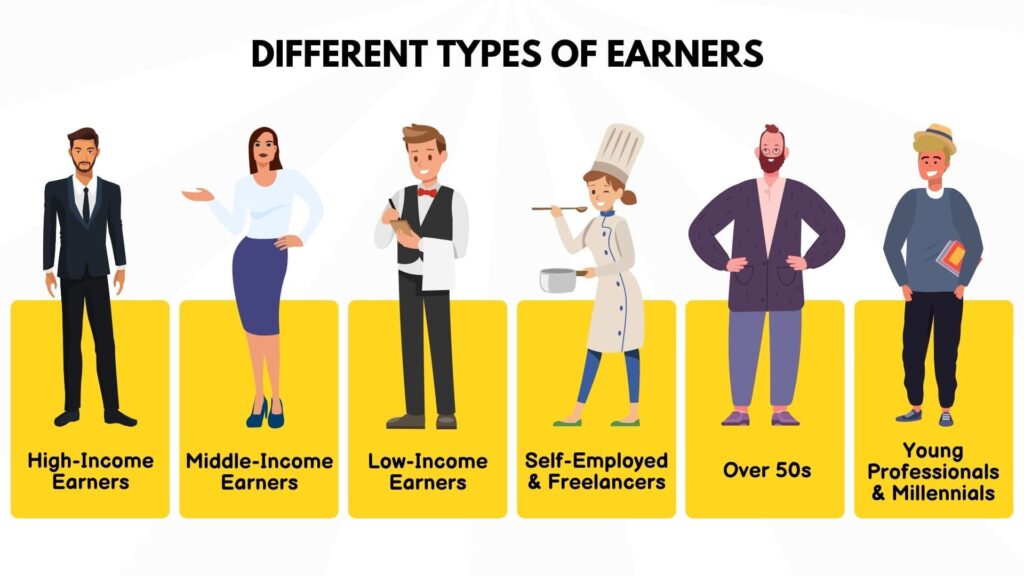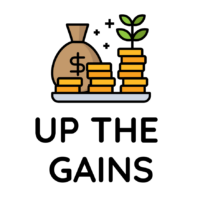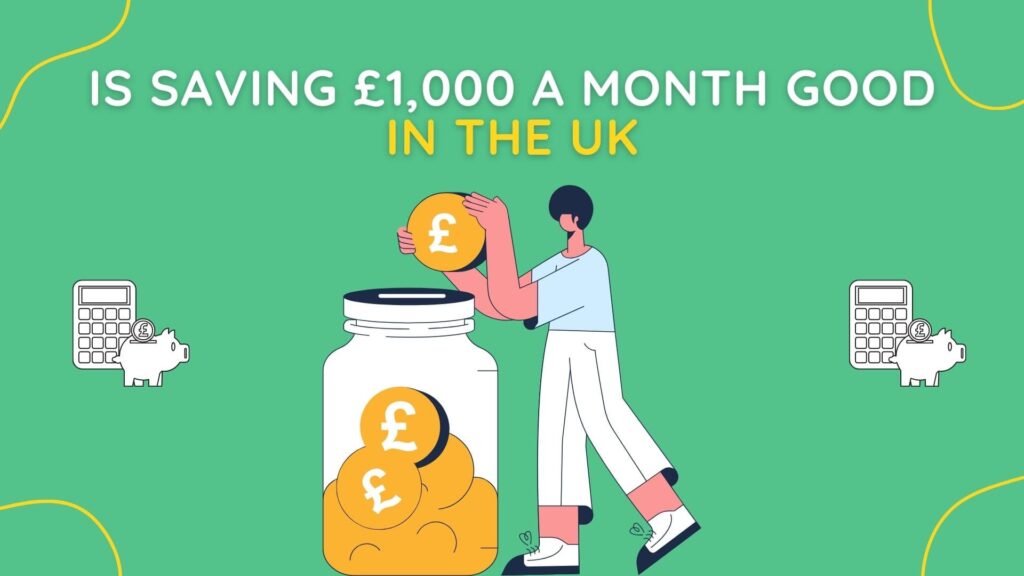
Sammie Ellard-King
I’m Sammie, a money expert and business owner passionate about helping you take control of your wallet. My mission with Up the Gains is to create a safe space to help improve your finances, cut your costs and make you feel good while doing it.

Quickfire Roundup:
The average monthly savings for a single person in the UK hover around £180-£200, while for the average household, the savings are about £450 per month.
With these figures in mind, saving £1,000 a month is indeed an ambitious target, putting you significantly ahead of the curve, whether you’re saving individually or as a household.
At this level of financial commitment, you’re not merely padding your accounts but significantly accelerating your path to a variety of financial milestones, be it buying a home, preparing for early retirement, or building a hefty investment portfolio.
So what can £1,000 a month achieve for you in the long run? Let’s delve deeper.
Is saving £1000 a month good enough? The answer would be a resounding yes for most people. However, the suitability of this amount can vary from person to person.
For those at the higher end of the income spectrum—say, in the top 1%—saving £1,000 might represent a relatively small portion of their monthly income. In such cases, a higher savings rate would likely be more appropriate.
But for the vast majority, stashing away £1,000 a month is an outstanding achievement, one that far outpaces the average savings rate in the UK.
Of course, individual circumstances such as living expenses, debt obligations, and long-term financial goals should be considered and everyone is always unique!
Table of Contents
Is Saving £1000 A Month Good?
Saving £1,000 a month equates to £12,000 a year, an amount that significantly boosts your financial capabilities. With such a robust annual contribution, you’ll be well on your way to building a considerable financial nest egg.
Given this level of saving, it’s advisable to look for the most competitive interest rates to maximise your returns.
Consulting a financial adviser or a money coach could provide you with personalised strategies to make the most of this sizeable monthly commitment.
Once you’ve built up a sufficient emergency fund, you’re in an excellent position to explore various investment opportunities.
With £12,000 saved per year, you could diversify your investment portfolio, increasing your potential for higher returns over the long term. Solid financial literacy is particularly crucial at this stage to ensure you make informed decisions.
Let the latest technology help get you there with the best money savings apps.
Listen to this 🎙️
Join us with Caro Syson, Pocket PA Founder and Entrepreneur.
We discuss how Caro has grown multiple business ventures, side hustles and a property empire but is now turning her hands to a new app to help business owners.
An inspiring podcast for those looking to level up their personal finances.
Hit the play button below or for the full episode with links to Apple and Spotify click Caro’s name above.
How Fast Will £1000 Grow With Interest Rate Scenarios
Let’s have a look at some interest rates and how they impact your returns over the long term.
| Years | 1% Annual Rate | 2% Annual Rate | 3% Annual Rate | 4% Annual Rate | 5% Annual Rate |
|---|---|---|---|---|---|
| 1 | £12,120 | £12,240 | £12,370 | £12,490 | £12,620 |
| 2 | £24,490 | £24,980 | £25,460 | £25,960 | £26,640 |
| 5 | £62,060 | £63,290 | £64,540 | £65,820 | £67,120 |
| 10 | £128,100 | £132,490 | £137,020 | £141,710 | £146,560 |
| 20 | £274,030 | £294,070 | £315,600 | £338,670 | £363,510 |
| 30 | £453,610 | £501,780 | £553,630 | £610,150 | £671,680 |
These figures are approximate and rounded to the nearest pound. They do not take into account any taxes or potential changes in your monthly contributions.
Why £1,000 a Month?
The figure of £1,000 a month often comes up in financial planning discussions for good reason.
This sum strikes a balance between being ambitious yet realistic, and it can significantly accelerate your financial growth.
Let’s look at some of the key areas where this monthly contribution can have a substantial effect.
Financial Security
Committing to a regular savings plan of £1,000 a month can swiftly create a solid financial cushion.
Saving £12,000 in just one year provides a substantial safety net to help you weather unexpected financial storms, be it job loss, medical emergencies, or urgent home repairs.
This amount offers peace of mind, reinforcing the assurance that sudden financial setbacks won’t disrupt your overall financial stability.

Financial Goals
With £1,000 set aside each month, reaching your financial milestones becomes significantly easier.
Whether it’s buying a new car, going on a luxurious holiday, or even starting a business, this level of consistent saving provides structure to your financial plans.
It helps turn ambitious financial objectives into achievable goals, setting you on the path towards financial freedom.
Financial Independence
For those eyeing the Financial Independence, Retire Early (FIRE) movement, £1,000 a month can accelerate your journey dramatically.
Such a substantial and consistent saving rate brings you closer to financial freedom and offers more lifestyle choices in the long run.
Investing Opportunities
A regular saving of £1,000 per month allows you to explore a broader range of investment opportunities. With this amount, portfolio diversification becomes more straightforward, providing you with the leeway to take calculated investment risks.
If you’re not sure where to begin, our “How To Invest £1,000” guide offers tips and tactics for getting the most out of this sum.
Or you can watch our video on it just below.
You can also check out the best stock trading apps for beginners here too.
Get On The Property Ladder
In the context of the UK property market, where the average deposit often exceeds £50,000, saving £1,000 a month can dramatically simplify the path to home ownership.
Within just over four years, you could save enough for an average deposit, and this doesn’t even factor in potential interest or investment gains.

Retirement Savings
Lastly, saving £1,000 each month can revolutionise your retirement planning.
Thanks to the magic of compound interest, this amount can grow into a significant nest egg that will provide financial comfort in your later years.
Let the latest technology help get you there with the best money savings apps.
How Much Should I Save Each Month?
Deciding the right amount to save each month can feel like walking a tightrope. Save too little, and you risk falling short of your financial goals.
Save too much, and you might find yourself scrimping on day-to-day necessities.
While there’s no one-size-fits-all answer to this pivotal question, there are key factors you can consider to help tailor a saving strategy that aligns with your individual circumstances.
In this section, we’ll delve into these factors, such as budgeting, emergency funds, investing, and retirement planning.
Create a Budget to Maximise Savings
The cornerstone of a strong financial plan is a comprehensive budget. Knowing precisely what you earn and what you spend will provide you with invaluable insights into your financial landscape.
By scrutinising your budget, you’ll find areas where you can reduce expenditures—not just small day-to-day expenses, but also significant commitments like mortgage repayments or car finance deals.
Once you have an accurate snapshot of your monthly spending, you can set a saving goal that suits you.
If, after budgeting, you find that £1,000 a month is either unattainable or more than you need, make the necessary adjustments.
- Sammie's Hot Tip 🌶️
Nobody enjoys budgeting but setting aside just 20 minutes a month will make such an enormous difference. When you’re saving £1,000 a month there’s probably room in your budget to get even more out of it. It’s time to maximise so get a solid budget done.
Have You Got an Emergency Fund?
An emergency fund is essential, regardless of your financial standing. This fund serves as a safety net for life’s unexpected curveballs, whether it’s a job loss, a car breakdown, or sudden medical costs.
Experts often advise having at least three to six months’ worth of living expenses in an easily accessible account.
If you’re starting from scratch, consider making building an emergency fund your initial priority. Once that’s in place, you’ll be freer to channel your savings into other financial ventures.
What About Retirement Savings?
Though retirement might seem like a distant concern, it’s never too soon to start preparing.
Employer-based pension schemes, especially those that offer matching contributions, are a prime way to ready yourself for later life.
If your employer matches your pension contributions, aim to contribute the maximum amount that gets employer-matched—it’s essentially free money.
Bear in mind that pension plans are for the long term, and early withdrawal can result in hefty penalties.
If you’re self-employed or don’t have the luxury of an employer-sponsored pension, you might want to explore setting up a personal pension or SIPP as they’re also know.
Check out the best personal pensions in the UK right here.
The State Of Savings In The UK
The average amount of savings in the UK differs vastly based on age group. According to savings statistics from the ONS, this is how each age group fairs:
- 18 to 24-year-olds – £2,481
- 25 to 34-year-olds – £3,544
- 35 to 44-year-olds – £5,995
- 45 to 54-year-olds – £11, 013
- 55 to 64-year-olds – £20,028
- 65 to 74-year-olds – £113, 600
So in just one year, with savings of £1,000 a month, you’d have more in savings than most under the age of 54! Not bad!
Contextualising £1,000 in Various Scenarios
Let’s delve into the different scenarios where saving £1,000 a month could be relevant, based on income levels and job roles.

High-Income Earners
For individuals on a six-figure salary, £1,000 might not seem like a large amount.
Nevertheless, it’s essential not to underestimate the compounding potential of this sum. In this income bracket, you might have sizeable financial commitments, such as mortgages on larger homes or private school fees.
A consistent £1,000 saving each month provides a stable financial cushion and can be an excellent diversification tool for your investment portfolio.
Financial advisors often recommend saving a more substantial percentage of your income when you’re a high earner, which could mean upwards of £3,000 to £4,000 per month.
Middle-Income Earners
For the average earner, £1,000 a month is a robust saving target. It’s achievable for many, while still significant enough to make a difference in the long run.
Life’s milestones, such as marriage, starting a family, or career transitions, could necessitate regular reassessments of your saving strategy. Inflation and the rising cost of living may even require you to adjust your monthly savings upwards.
Low-Income Earners
For those at the lower end of the income scale, saving £1,000 a month might seem overly ambitious. But remember, any consistent saving is better than none.
Rather than sticking to a fixed sum, consider setting aside a percentage of your income. Government support schemes designed to assist low-income earners could also be beneficial.
The Self-Employed and Freelancers
For freelancers and the self-employed, whose income can vary month-to-month, a rigid £1,000 saving strategy could be challenging. Adaptability is crucial here.
Consider saving more than £1,000 in the months when you’re flush, building a buffer for the leaner periods.
The Over 50s
If you’re over 50 and haven’t prioritised saving up until now, setting aside £1,000 a month can be a crucial step towards a more comfortable retirement.
Look into options like catch-up contributions to your pension scheme to maximise your retirement savings.
Young Professionals and Millennials
For younger individuals, the magic of compound interest works best with time on your side. While £1,000 a month might seem steep when you’re early in your career, keep in mind that salary increments and career advancements can make this goal more attainable in the long run.
MORE LIKE THIS
Conclusion
Steering through the intricate maze of personal finance can feel overwhelming, but having a robust savings plan serves as a fundamental cornerstone.
By setting aside £1,000 a month, or an amount that’s more aligned with your earnings, you’re not just stowing away cash—you’re investing in a financially secure future.
Whether it’s building a substantial emergency fund or capitalising on various investment avenues, regular savings play an instrumental role in achieving long-term financial stability.
So, whether you’re embarking on your savings journey or looking to refine your current strategy, never underestimate the transformative potential of consistently saving a segment of your monthly income.
While financial stability may seem like an elusive target, it becomes increasingly attainable with a well-considered strategy and disciplined saving habits.
Share on social media
Disclaimer: Content on this page is for informational purposes and does not constitute financial advice. Always do your own research before making a financially related decision.



